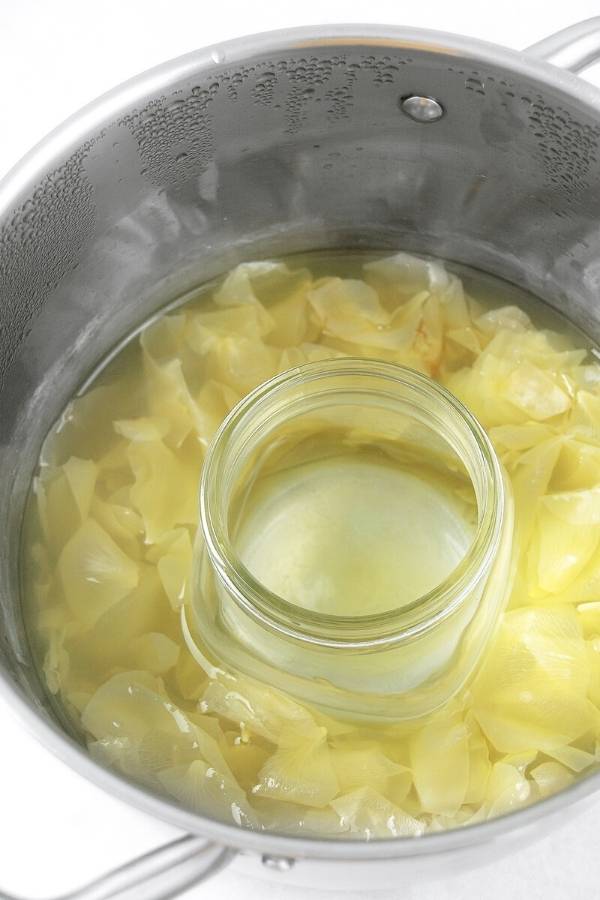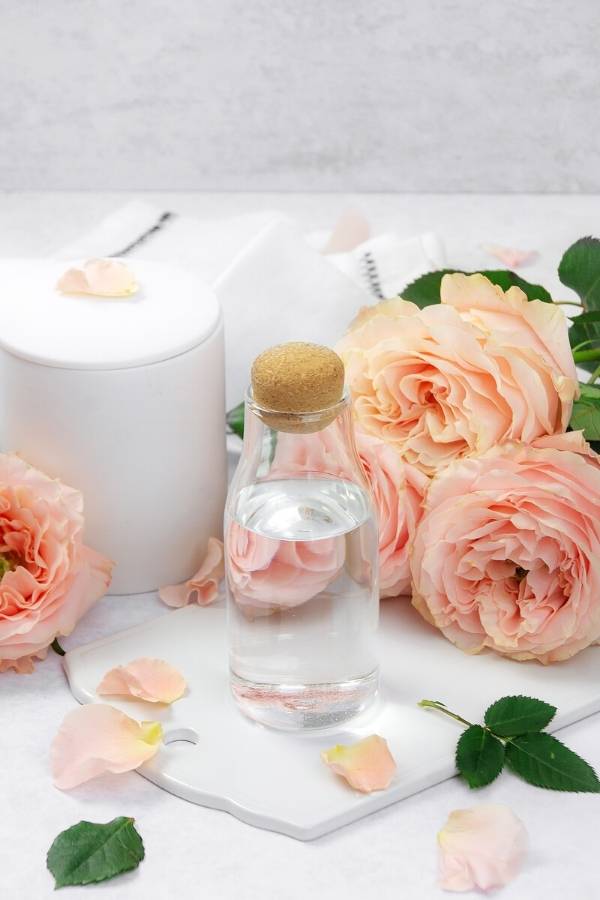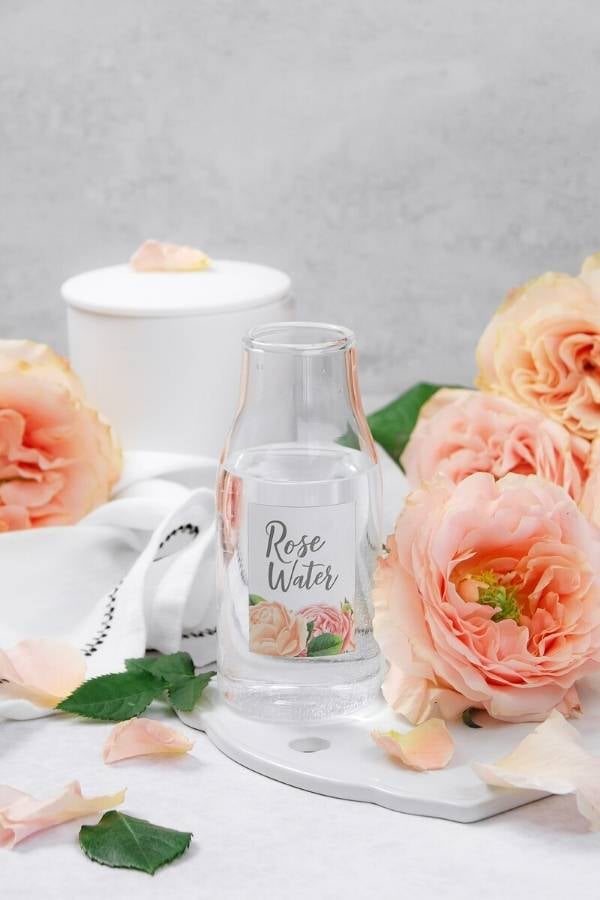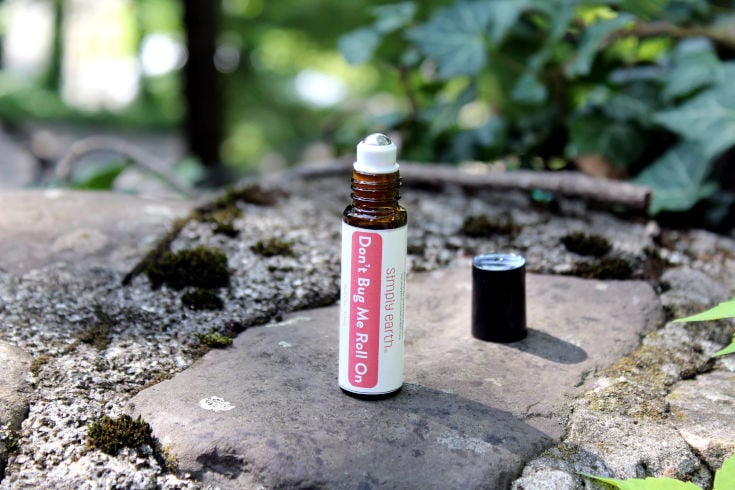
How To Make Rose Water and Flower Water Benefits (Distillation Method)
Learn how to make rose water at home! This sweetly fragrant floral water is made with fresh rose petals and makes a wonderful addition for skincare DIYs, home fragrance, and aromatherapy recipes. This tutorial explains the benefits of rose hydrosol and shows different ways to use your homemade flower water recipe.

DIY Rose Water
Calling all rose lovers! This DIY rose water is loaded up with an exquisite rose fragrance, has countless benefits for the body and mind, and can be incorporated in many skincare formulations. You’ll love it!
I shared an easy homemade rose water recipe a couple of years back, where I showed a “cold brew” method for making rose hydrosol at home. Today, I want to show you how to make rose water via steam distillation.
Although it sounds complicated, crafting your own rose hydrosol is easier than you think. I’ll walk you through the whole process step-by-step, and we’ll also talk about the benefits and uses of flower water.
Continue reading to discover how to utilize the steam distillation method to make DIY rose water at home. Plus get tips on the best roses to use, how to preserve and store floral waters safely, shelf life and ways to use rose hydrosol for skin care and natural home fragrances. I also share an easy recipe for homemade rose water along with its benefits for natural beauty, skin care and aromatherapy.

Rose Water Benefits
Rose water is known for its skin-soothing qualities and calming scent. The hydrosol contains various plant compounds, such as linalool, citronellol, geraniol, antioxidants, and rose oxide.
Due to its anti-inflammatory properties, rose water can ease skin irritations and inflammation. Being a mild astringent, the floral water is also a natural toner and can improve the appearance of large pores and blemishes. Rose hydrsol is suitable for all skin types, including sensitive skin, eczema, acne, and psoriasis.
Rose hydrosol also contains small amounts of phenyl ethyl alcohol, which lends the floral water antibacterial and antiseptic effects. Although not a replacement for a disinfectant, you can use rose floral water to clean minor cuts, lacerations, and burns.
The scent of roses is also incredibly uplifting. Inhaling the rose aroma can improve your mood and wellbeing. Rose flower water can be beneficial to ease mental health conditions like anxiety, stress, tension, and grief.

Materials and Tools for Homemade Rose Water
Bursting with a lush rose scent, this floral hydrosol is every rose lover’s dream. But before we get started on making homemade rose water, gather the following supplies:
- Fresh rose petals
- Distilled water (Or filtered water.)
- Preservative (I used Linatural, a natural broad-spectrum preservative.)
- Heatproof jar or container (I used a 16-oz mason jar.)
- Large pot with lid (Make sure the lid fights tightly, so the steam doesn’t escape.)
- Ice cubes (To cool down the steam.)
- Kitchen tongs (To handle the hot jar).
- Funnel
- Glass bottle (You can also use a glass bottle with a spray mister.)

How to Make Rose Hydrosol
DIY rose water is easy to make – a pot of boiling water does all the work for you. Follow my simple instructions, and you’ll be making your own flower water in no time. This is what you do:
Prep the Rose Petals
Cut 3 to 4 fully blooming roses from the garden. Gently pull the petals off the stem and put them into a bowl. Look through the petals and remove any that are wilted or have brown spots. Discard the stem. Rinse the rose petals thoroughly under cool, running water to remove bugs and dirt, then drain.

Set Up the Boiler
Put the heat-resistant mason jar into the center of a large, deep pot. Arrange the rose petals around the jar. Fill up with distilled water until the petals are submerged. You want to use 1 part petals to 1 part water. The petals will float on the water surface, and you can push them down into the water.

Distill the Rose Hydrosol
Cover the pot with an upside-down lid and bring to a gentle simmer (don’t boil). Cook for 20 minutes. As the water simmers, the steam will rise to the lid, where it will cool and condensate (become liquid again) and then drop into the mason jar.
To help the stem cool down quicker, put a few ice cubes on the lid. Using kitchen tongs, take the mason jar out of the pot. Place it on a kitchen towel and let cool to room temperature.
Preserve the Rose Water
Once the rose water has cooled to room temperature, add the preservative. Give the flower water a good stir to ensure the preservative is evenly distributed throughout. Linatural is heat sensitive. So be sure the rose floral water feels cool to the touch. If the hydrosol is too warm, the efficiency of the preservative can be diminished.
Store
Using a funnel, transfer the rose water into an airtight bottle and keep it at ambient temperature.

Label
It’s important to label your products. As many natural products look similar, labeling the rose hydrosol will ensure you don’t confuse it with a different product in your home. I also recommend writing the date you prepared the DIY rose water on the label. This way you can be sure to toss it once it reaches the end of its shelf life.
If you like the labels I use for my homemade rose hydrosol, you can download and print the labels here.

Rose Hydrosol Uses
If you’ve never used rose-scented flower water before, prepare to be wowed. You can use your DIY rose water recipe in sheer endless ways. Just note that rose floral water is soluble in water and alcohol but insoluble in oils (unless you add an emulsifier).
And be careful when heating rose water. The bioactive compounds evaporate under high heat, and the rose water loses its benefits.
You can use flower hydrosols in any body and skin care recipe that calls for water or distilled water or as a substitute for another hydrosol. Here are a few of my recipes that feature rose water as an ingredient:
For a quick rose water hair rinse, mix 1 cup rose hydrosol with 1 tablespoon apple cider vinegar. Apply the mixture to your hair after shampooing and conditioning. The hair rinse will close the hair cuticles and add shine to your locks.
Another idea is to fill your flower water into a fine mister bottle and use it as a DIY room spray or homemade linen mist. The luxurious rose scent will freshen up any space and give stale linen a pleasant smell.
Feeling down? Rose hydrosol can lift your mood and reduce anxiety and stress. Simple spritz the flower water on your body or clothes and enjoy. I also like to spritz a little into the air when I meditate or do yoga.
You can also visit Country Hill Cottage to explore more ways to use rose floral water to make rose water toner here as well as to learn about its benefits
For more ideas, check out my guide on how to use hydrosols for skin, face, and hair.

FAQ and Troubleshooting
What is steam distillation?
Water-steam distillation is a traditional method to extract compounds from plant materials (flowers, petals, and leaves). In this extraction method, distilled water and plant matter are heated in a boiler. The volatile plant compounds vaporize and bind with the steam. The steam is then caught and cooled, rendering it liquid again.
What is hydrosol?
Hydrosol or plant waters are botanical extracts. Floral waters, like rose, lavender, and cornflower, are very popular, but other types of hydrosols exist, for example, hydrolats made from spices, wood, herbs, and fruits.
As I’ve just mentioned, hydrosols contain trace amounts of bioactive plant compounds, the essence of the plant if you will. Compared to essential oils, hydrolats are much milder and even safe for those who react sensitively to essential oils.

What are the best roses for rose water?
You can make rose water from any roses that have a scent. Traditionally, rose hydrosol is made from one of two roses species:
- Damascena Rose (also known as rose otto damascene) is a staple in perfumery and has an intoxicatingly rich, heady rose aroma. Rose essential oil is often made from the damask rose.
- Centifolia Rose (also called Rose de Mai, cabbage rose, or Provence rose) was cultivated by Dutch breeders in the 17th century. This rose family produces an exquisite rosy scent that is light and sweet.
The briar rose (aka sweetbriar rose, dog rose, or wild rose), which has a delicious apple-like rose fragrance, and old garden roses are great options for making flower water with roses at home, too.
Should I use blooming roses or rosebuds?
Rose petals are best for homemade rose hydrosol, so opt for roses in full bloom rather than rosebuds.
When is the best time to harvest roses?
The best time to pick roses from your garden is in the morning hours or in the evening after watering them. Don’t cut roses when the sun burns down on them, and the rose heads look droopy.
Can I buy roses from the flower shop?
Yes, but with reservations. Homegrown roses are best, but of course, I understand that’s not an option for everyone. When buying from a florist, ask for damascena or centifolia roses and only buy organically grown flowers.
Conventional roses are often heavily treated with toxic chemicals (pesticides, fungicides, etc.). You don’t want these chemicals in your floral water. Florist roses also often have no or little aroma, which would result in scentless rose water.
You can also order fresh roses online or buy a small rose bush in a garden center.

Does homemade rose water need a preservative?
Yes, homemade rose water needs a preservative if you plan on keeping it for a while. I added Linatural, a natural broad-spectrum preservative that is often used to preserve hydrosols. Just 0.5% is enough to protect your natural flower water recipe from bacteria, yeast, and mold.
Some commercial hydrosols and flowers waters are made without a preservative. But keep in mind that these hydro- sols are produced with professional equipment in labs, where the chances of contamination are greatly reduced. We can’t recreate lab conditions at home.
You can make rose hydrosol without a preservative if you:
- Intend to use the flower water right away.
- Want to consume your floral water (e.g., to make rose lemonade.)
- Need it as an ingredient in another skincare formulation (for example, a body lotion recipe.)
Why is my rose water clear?
Steam-distilled floral water is always colorless. For a touch of pink, dissolve 1/8 tsp pink pitaya powder in your clear flower water.
Why does my rose water have no scent?
Scentless rose hydrosol means that you either used roses that had no scent to begin with or that you distilled the petals at too high of a temperature.
How to Store Rose Water
I keep my flower water in a tightly closed bottle in a cupboard at room temperature. You can also store your DIY rose water in the fridge. For the best shelf life, ensure that the product isn’t exposed to direct sunlight.
Homemade Rose Water Shelf Life
To be safe, use preserved flower water within 6 months. Store rose floral water without a preservative in the refrigerator and use it within a week. Discard the hydrosol if you see mold or notice a change in smell or color.
Rose Water Recipe

Learn how to make rose water at home using the steam distillation method. This sweetly fragrant recipe for floral water is made with fresh rose petals and is an excellent addition to skin care recipes as well as home fragrance and aromatherapy recipes.
Materials
- 3 cups fresh rose petals (from 3 to 4 large roses)
- 3 cups distilled water (or filtered water)
- 1/2 tsp Linatural (preservative)
Tools
- heatproof jar or container (I used a 16-oz mason jar)
- large pot with lid
- ice cubes
- kitchen tongs
- funnel
- glass bottle
Instructions
- Cut 3 to 4 fully blooming roses from the garden. Gently pull the petals off the stem and put them into a bowl. Look through the petals and remove any that are wilted or have brown spots. Discard the stem.
- Rinse the rose petals thoroughly under cool, running water to remove bugs and dirt, then drain.
- Put the heat-resistant mason jar into the center of a large, deep pot. Arrange the rose petals around the jar. Fill up with distilled water until the petals are submerged. You want to use 1 part petals to 1 part water. The petals will float on the water surface, and you can push them down into the water.
- Cover the pot with an upside-down lid and bring to a gentle simmer (don’t boil). Cook for 20 minutes. As the water simmers, the steam will rise to the lid, where it will cool and condensate (become liquid again) and then drop into the mason jar.
- To help the stem cool down quicker, put a few ice cubes on the lid.
- Using kitchen tongs, take the mason jar out of the pot. Place it on a kitchen towel and let
cool to room temperature. - Once the rose water has cooled to room temperature, add the preservative. Give the rose
water a good stir to ensure the preservative is evenly distributed throughout. Linatural is heat sensitive. So be sure the rose water feels cool to the touch. If the hydrosol is too warm, the efficiency of the preservative can be diminished. - Using a funnel, transfer the rose water into an airtight bottle and keep it at ambient temperature.
The Best Rose Hydrosol to Buy
No time to DIY? If you’re a longtime reader of my blog, you know that I’m a big fan of Mountain Rose Herbs. They have a wide range of floral hydrosols and offer a fragrant damascene rose hydrosol and a unique white rose hydrosol.
Where to Find More Information
Need additional help learning how to make rose hydrosol? For a detailed instructional course on how to make hydrosols, I recommend the Botanical Skin Care Course offered by The Herbal Academy.
Not only does this course provide additional information on how to make herbal and floral hydrosols, this course also covers other herbal preparations for making natural skin care products, offers research on the relation between nutrition and your skin, and provides over 200 recipes to craft at home. (You can read my Botanical Skin Care Course review here.)
For more DIY recipes, make sure to follow Soap Deli News on Facebook, Twitter, Pinterest, and Instagram. Or subscribe to my newsletter.



8 Comments
Meryll Hipperson
August 4, 2021 at 9:36 am
Hi , just wondered after you have collected the water could you simmer the same petals again to make more rose water?
Rebecca D. Dillon
August 4, 2021 at 7:50 pm
You would need to start with fresh rose petals.
Dorene Kloby
August 18, 2021 at 10:39 am
Just to be clear, are we also using the water from the pot that the petals are submerged in or just the condensation that fell into the mason jar
Rebecca D. Dillon
August 23, 2021 at 3:17 pm
Just the condensation that fell into the mason jar.
Julie
May 4, 2022 at 1:53 pm
Enjoyed this and can’t wait to try this! About how much does this yield? Thank you!
Rebecca D. Dillon
May 6, 2022 at 9:51 am
1/3 Cup.
Donna Adler
May 17, 2022 at 11:09 pm
Is there any use for the water that the roses were boiled in?
Rebecca D. Dillon
June 7, 2022 at 3:51 pm
You can use it to water your plants!
Comments are closed.